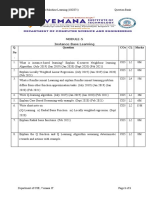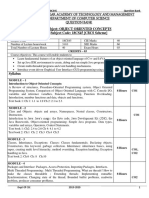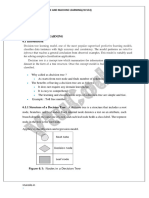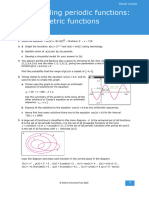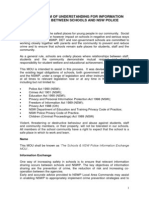Data Structures
Uploaded by
itsfack17132Data Structures
Uploaded by
itsfack17132DR.
BABASAHEB AMBEDKAR TECHNOLOGICAL UNIVERSITY, LONERE
Supplementary Summer Examination – 2024
Course: B. Tech Branch: Computer Engineering/Computer Science and Engineering Sem: III
Subject Name: Data Structures Subject Code: BTCOC303
Max Marks: 60 Date: - 04/07/2024 Duration: - 3 Hrs.
Instructions to the Students:
1. All the questions are compulsory.
2. The level of question / answer as per OBE or the Course Outcome (CO) on which the question is
based is mentioned in ( ) in front of the question.
3. Assume data wherever necessary and mention it clearly.
(Level / CO) Marks
Q. 1 Solve any Two of the following
1. What is primitive data structure? Differentiate between primitive and Understand 6
non-primitive data structures.
2. Define space complexity of an algorithm. Determine the space Analyze 6
complexity of the following program segment:
int sum(int a[ ], int n)
{
int x = 0;
for (int i=0; i<n; i++)
{
x = x + a[i];
}
return x;
}
Note: Assume integer variable takes 4 bytes of memory space.
3. Define collision. Consider a hash table of size 13 and the hash function Apply 6
given is h(x) = x mod 13. Demonstrate how Linear probing handles
collision while inserting keys 18, 41, 22, 44, 59, 32, 31, 73, in this
order.
Q.2 Solve any Two of the following
1. Consider the stack of size 5 memory cells. Suppose initially stack Apply 6
contains A, B, C, D (Top of stack). Then the following operations are
executed in order. Show the stack top and any other situation raised
while doing each of the operations.
i) Push(E) ii) Pop(top) iii) Push(F) iv) Push(G) v) Pop(top) vi) Push(H)
2. Write algorithms for enqueue and dequeue operations on circular queue Evaluate 6
with example.
3. Explain with suitable example concept of binary recursion. Apply 6
Q.3 Solve any Two of the following
1. Describe circular linked list operations in detail. Evaluate 6
2. What is garbage collection? Who will run garbage collection program? Remember 6
3. Justify a linked list is a data structure that is based on dynamic memory Understand 6
allocation. List the advantages of linked list dynamic memory
allocation.
Q.4 Solve any Two of the following
1. Explain different binary search tree traversal methods. Understand 6
2. How does graph can be represented using adjacency matrix? What will Apply 6
be the adjacency matrix for the below given directed weighted graph?
A 5 B 3 E
6 2 4
C D F
9 7
3. Write short note on balanced trees. Understand 6
Q.5 Solve any Two of the following
1. Describe how dictionaries can be implemented using skip lists. Evaluate 6
2. What is selection sort? Explain in detail with suitable example. Apply 6
3. Write short note on file handling. Understand 6
*** End ***
You might also like
- Advanced Logic Synthesis: Multiple Choice QuestionsNo ratings yetAdvanced Logic Synthesis: Multiple Choice Questions16 pages
- BTCOC305 (A) Object Oriented Programming in C++No ratings yetBTCOC305 (A) Object Oriented Programming in C++1 page
- Dayananda Sagar Academy of Technology and Management Department of Computer Science Question Bank100% (1)Dayananda Sagar Academy of Technology and Management Department of Computer Science Question Bank9 pages
- Unit-5 Unit-5: Case Studies of Big Data Analytics Using Map-Reduce ProgrammingNo ratings yetUnit-5 Unit-5: Case Studies of Big Data Analytics Using Map-Reduce Programming11 pages
- Cse - Iot IV Years Cs & Syllabus Ug r20No ratings yetCse - Iot IV Years Cs & Syllabus Ug r20168 pages
- Data Storage On Fingernail Seminar TopicNo ratings yetData Storage On Fingernail Seminar Topic20 pages
- Cs3353 Foundations of Data Science L T P C 3 0 0 3No ratings yetCs3353 Foundations of Data Science L T P C 3 0 0 32 pages
- @vtucode - in - CN QUESTION BANK 2021 SCHEMENo ratings yet@vtucode - in - CN QUESTION BANK 2021 SCHEME7 pages
- M Tech 1sem BDA Question Paper With AnswersNo ratings yetM Tech 1sem BDA Question Paper With Answers98 pages
- @vtucode - in Module 4 AI 2021 Scheme 5th SemNo ratings yet@vtucode - in Module 4 AI 2021 Scheme 5th Sem11 pages
- Super Important Questions For BDA-18CS72: Module-1No ratings yetSuper Important Questions For BDA-18CS72: Module-12 pages
- 21gnh101j Philosophy of Engineering 445566666No ratings yet21gnh101j Philosophy of Engineering 4455666662 pages
- JNTUA Advanced Data Structures & Algorithms Notes R20No ratings yetJNTUA Advanced Data Structures & Algorithms Notes R20150 pages
- Clinical Teaching On Cardiac RehabilitationNo ratings yetClinical Teaching On Cardiac Rehabilitation14 pages
- Time, The Protector From Crime. Police Men Get A Corporate Identity From The Uniform TheyNo ratings yetTime, The Protector From Crime. Police Men Get A Corporate Identity From The Uniform They1 page
- Technical Analysis: DR - Manish Dadhich Mba, Net, SetNo ratings yetTechnical Analysis: DR - Manish Dadhich Mba, Net, Set51 pages
- Scope of Study: Introduction of Competition LawNo ratings yetScope of Study: Introduction of Competition Law10 pages
- Inbound Logistics. The Majority of Samsung Suppliers Are Based in Asia and AccordinglyNo ratings yetInbound Logistics. The Majority of Samsung Suppliers Are Based in Asia and Accordingly4 pages
- Emery 2020 The Importance of Self Care For Improving Student Nurse WellbeingNo ratings yetEmery 2020 The Importance of Self Care For Improving Student Nurse Wellbeing1 page
- Quotation of Gait Training Electric WheelchairNo ratings yetQuotation of Gait Training Electric Wheelchair2 pages
- Reading Comprehension Practice Passages Competitive Exams: Airbus Crisis Over100% (1)Reading Comprehension Practice Passages Competitive Exams: Airbus Crisis Over3 pages
- Chapter 5 Internal Enviroment Analysis PDFNo ratings yetChapter 5 Internal Enviroment Analysis PDF31 pages
- Understanding Strategic Management Cap. 3 Anthony E. Henry Oxford Prez TOMA100% (1)Understanding Strategic Management Cap. 3 Anthony E. Henry Oxford Prez TOMA20 pages









